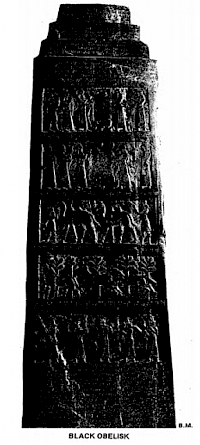Latest Posts
View the latest posts in an easy-to-read list format, with filtering options.

These are basic biblical themes that are necessary in order for prophets to understand what the biblical prophets have already prophesied.
Category - General

The story of Israel is not complete without an understanding of its incremental restoration in a new form. In fact, the main controversy centers on the question of how Israel’s restoration is being fulfilled today at the end of the age.
Most Christians believe that the Jewish state fulfills this prophecy, because they have assumed that the Jews are Israelites. Most Jews, however, know that they are not the Israelites of prophecy, because, they had prayed for thousands of years to be reunited with the House of Israel—that is, the ten tribes that were seemingly lost in Assyria. Yet in 1948, when they established their state, they chose to call their nation Israel, rejecting other names that had been proposed, such as Judah and the Kingdom of Judah.
In other words, they adopted a form of Replacement Theology, where Judah essentially replaced Israel as the inheritors of the promise. Most Christians, by this time, had forgotten the difference between Israel and Judah, and so they readily supported this claim.
The Dispensationalist view of prophecy, set forth in the 1850’s by Darby (and later popularized by Scofield) assumed that there was no difference between a Jew and an Israelite.
So when they read verses such as Jer. 5:11, they thought the prophet was stuttering,
11 “For the house of Israel and the house of Judah have dealt very treacherously with Me,” declares the Lord.
Likewise, when Jeremiah clearly distinguished between Israel and Judah in Jeremiah 18 and 19, Christian prophecy teachers seemed to have a veil over their eyes. For this reason, they focused on the good prophecy of Israel in Jer. 18:1-10 and applied it to Judah. They completely missed the point of Jeremiah’s prophecy and failed to see how it contrasted with the prophecy of utter destruction directed at Judah and Jerusalem (Jer. 18:11 to Jer. 19:15).
So this blindness caused Christians to accept the new Replacement Theology, and this was also why the Jewish Zionists chose also to call their new state Israel. If the people had understood the implications of the Divided Kingdom, if they had understood that Judah possessed the Dominion Mandate while Israel possessed the Birthright (i.e., the Fruitfulness Mandate)—as stated clearly in 1 Chron. 5:1, 2—and if they had studied the history of the lost tribes of Israel, they would not have made such a mistake.
In fact, if they had understood God’s definition of a Jew in Rom. 2:28, 29, and if they had understood that not all (fleshly) Israelites are actually Israelites in the sight of God (Rom. 9:6), they might have avoided the fundamental errors of Dispensationalist eschatology. It remains, then, for us to study these things, so that we can obtain a clearer Kingdom vision and thereby avoid supporting the counterfeit simulation of the restoration of Israel.
The Israelites were never really lost. When they were taken to Assyria, the Assyrians settled them in what they called the land of Gamir. Historians know precisely where the land of Gamir was located, because it is mentioned numerous times in the clay tablets that were retrieved when the great library in Nineveh was excavated from 1900-1930.
The results of that archeological project were published in four volumes by the University of Michigan Press in 1930 under the title: Royal Correspondence of the Assyrian Empire, by Leroy Waterman. (I have these four volumes in my library.)
More recently (1985), Professor E. Raymond Capt (1914-2008) wrote a review of Waterman’s books, which he entitled, Missing Links Discovered in Assyrian Tablets.
https://www.amazon.com/Missing-Links-Discovered-Assyrian-Tablets/dp/0934666156
I met him in 1975 and we held two conferences together in 1981, where he gave an archeological lecture, and I followed up with a corresponding Bible study. Here is a picture of him.
The Bible itself says in 2 Kings 17:6,
6 In the ninth year of Hoshea, the king of Assyria captured Samaria and carried Israel away into exile to Assyria, and settled them in Halah and Habor, on the river of Gozan and in the cities of the Medes.
Toward the end of the first century A.D., the Jewish historian, Josephus, wrote,
“Wherefore there are but two tribes in Asia and Europe subject to the Romans, while the ten tribes are beyond Euphrates till now; and are an immense multitude, and not to be estimated by numbers” (Antiquities of the Jews, XI, v, 2).
James also knew who they were, for his letter is addressed to all twelve tribes, including both the dispersed Jews (2 tribes, Judah and Benjamin) and the ten tribes of Israel. James 1:1 says,
1 James, a bond-servant of God and of the Lord Jesus Christ, to the twelve tribes who are dispersed abroad: Greetings.
I mentioned earlier that Peter also wrote his letters to some dispersed Israelites living near the Black Sea (1 Peter 1:2, 3).
It is clear, then, that even in the time of Jesus’ apostles, the whereabouts of the Israelites were well known. They were “lost” only in the sense that they had been cut off from the covenants and so they were “not My people,” as Hosea would say.
In the eyes of God, the name Israel is a title given to overcomers, that is to say, the remnant of grace. Jacob received that name only after he wrestled with the angel at the age of 98. His descendants were named Israelites in a genealogical sense, but this was conditional. If they failed to live up to the testimony of that name, they could be cast out—which is precisely what happened.
 The Israelites who were taken to Assyria soon lost their name, and this was the main reason they were eventually lost. It is important to know that only the Israelites called themselves Israel. The Assyrians called them Gimirri, or Khumri, as seen on the Moabite Stone and the Black Obelisk of Shalmaneser. Here is a picture of the Black Obelisk. It pictures the Israelite king Jehu bowing before the Assyrian king. Jehu is referred to as Bit-Khumri, that is, “son of Omri.” Omri was the Israelite king who set up diplomatic relations with Assyria, and from then on, Assyria referred to Israel as the house of Omri (“Khumri”).
The Israelites who were taken to Assyria soon lost their name, and this was the main reason they were eventually lost. It is important to know that only the Israelites called themselves Israel. The Assyrians called them Gimirri, or Khumri, as seen on the Moabite Stone and the Black Obelisk of Shalmaneser. Here is a picture of the Black Obelisk. It pictures the Israelite king Jehu bowing before the Assyrian king. Jehu is referred to as Bit-Khumri, that is, “son of Omri.” Omri was the Israelite king who set up diplomatic relations with Assyria, and from then on, Assyria referred to Israel as the house of Omri (“Khumri”).
https://en.wikipedia.org/wiki/Black_Obelisk_of_Shalmaneser_III
After the fall of Assyria, when the Israelites were free to immigrate to any part of the world, many of them migrated into Europe as Khumri, Cymru, Cambrian, Celts and other variations of the name.
The Welsh in Britain still call themselves Cymru to this day.
https://www.thefreedictionary.com/Cymru
As we know from history, the Babylonians conquered Assyria (612-607 B.C.), and 70 years later, the Persians conquered Babylon (537 B.C.). Still later, when the Persian king Darius died, he was buried in a tomb in the mountain called Behistun. Over his tomb was a list of all the nations that he ruled. They were listed in three languages. In one language the Israelites were called Gimirri; in another they were called Saka, in another, they were called Sakka.
It is clear, then, that the Gimirri-Israelites (in the land of Gamir) were also known as Saka and Sakka in other languages. The Greek historians wrote this as Sacae, and the Romans historians, using the Latin language, wrote these names as Saxons.
These are the names of the Israelites in dispersion after they lost their name, Israel. We can also say that these are the “not My people” names of the ex-Israelites of the dispersion. By knowing these names, we can more easily trace the lost tribes of Israel as they immigrated into Europe. It can be said that Israel’s graveyard in Assyria was the birthplace of Europe. Because many of them traveled north through the Caucasus Mountains, historians refer to them as Caucasians.
So for those who like to think of Jews and Israelites in genealogical terms, we see that the Israelites were never known as Jews, and that the Israelites became the Europeans.
C. S. Lewis knew this. His books are allegories of various parts of church history. But two of his books portray the lost tribes of Israel. They are Prince Caspian and The Voyage of the Dawn Treader. He chose the name Caspian because the Assyrians settled the exiled Israelites around the Caspian Sea. The Voyage of the Dawn Treader is a story about finding lost people and also about making invisible people visible.
Therefore, we cannot properly refer to Jews as Israelites, even though Judah was once a part of Israel. Those who are truly of the tribe of Judah must eventually become Israelites by being united with the tribes of Joseph. Only then can they have a share in the Birthright. And to do that, one must become one with Christ in His second appearance as “Joseph,” with His robe dipped in blood (Rev. 19:13).
The bottom line is that no one—not even those who are descended from the ancient Israelites—can be given the name Israel unless they are in unity with Christ in His second appearance. Jews are not privileged to be called Israelites apart from Christ. The state called Israel, then, is not in accordance with the mind of God.